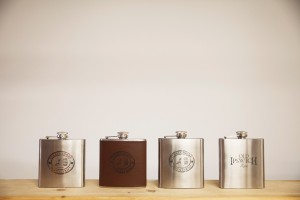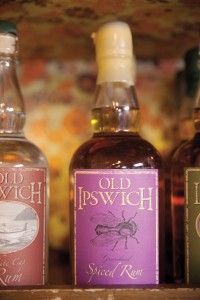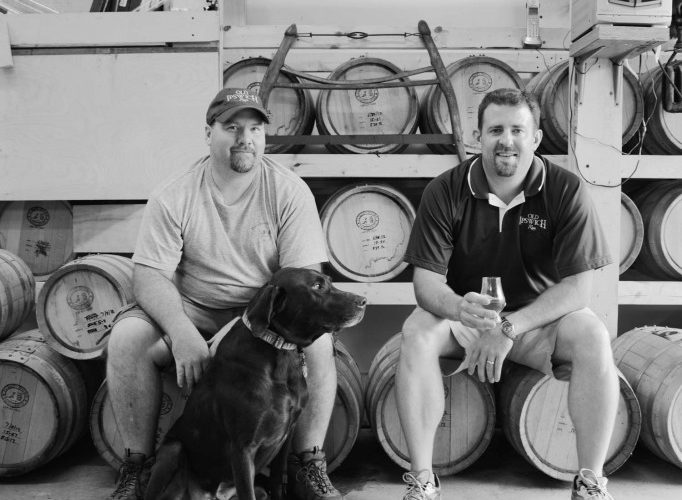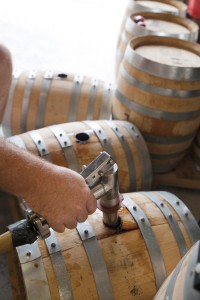At Turkey Shore Distillieries, a pair of boyhood friends reintroduces New England-style rum to Ipswich. By Jeanne O’Brien Coffey
When boyhood friends Mat Perry and Evan Parker discovered that a rum distillery once stood on the street where they grew up-and the molasses for that rum arrived at a wharf that was now Perry’s backyard-it seemed like destiny. After all, the pair had been discussing the possibility of crafting their own artisanal rum for years.
“Back then, barrels of molasses were rolled across the street from the wharf to the distillery,” says Parker, master distiller at Ipswich’s Turkey Shore Distilleries. While the wharf is now just overgrown pilings in Perry’s parents’ backyard, the history of the area got under the pair’s skin.
In 2010, they launched Turkey Shore Distilleries, now producing about 400 gallons of premium rum each month-about 1,700 to 2,000 cases a year. Turkey Shore is one of a handful of small batch distillers cropping up on Cape Ann, including Privateer Rum, also in Ipswich, and Ryan and Wood in Gloucester, marking a Renaissance in rum production in the area. In the 1700s, there may have been as many as 160 rum distilleries in New England, but by the time of Prohibition in the 1920s, all had disappeared. Now, there are six artisanal rum producers in Massachusetts, and the small batch rum business is the fastest-growing segment in the distilled alcohol category.
“These micro distilleries in the USA are what I would call ‘the new kids on the block,’ trying to build their own identity with rum,” says Margaret Ayala, consultant, author, publisher of Got Rum? magazine, and founder of The Rum University. “With the East Coast having had a big part in rum from its early days of colonization, there seems to be a big move to redevelop ‘New England’ style rums,” Ayala says, adding that the New England style was typically a fuller bodied one than Puerto Rican rums, with floral and fruity elements.
At Turkey Shore, the lifelong friends are taking the New England style to the extreme, trying to recreate the flavors the colonists would have experienced 240 years ago. “What we attempt is to mimic how they would have made the rum back then-the ingredients and the process,” says owner/distiller Perry.
The original 1770 distillery sat on a part of the Ipswich River known as Turkey Shore-which became the name of the street the pair grew up on. Aided by Perry’s background as a history teacher, Parker and Perry spent days meeting with local historians, as well as poring over documents at the Ipswich Museum and in the stacks at the Ipswich Public Library, piecing together information describing the original still, the process, and the flavor of the rum before heading into the kitchen to try out some batches.
“It’s kinda hard to drop a half million dollars into a business without ever having done it before,” Perry says. “We felt obliged to at least get a sense for it.” Don’t try this at home, though, he warns- while it’s okay to make your own beer and wine, it turns out that cooking up a distilled spirit is actually illegal, a fact they learned only later.
Parker and Perry started with the base ingredient they feel is closest to what our forefathers would have had available: molasses. While most rum makers these days use sugar cane juice as their raw material, Turkey Shore research showed that for the original Massachusetts Bay Colony, it had to be molasses-and not just any molasses, either.
“Back 250 years ago, they only had one type of molasses,” Parker explains. “They didn’t have the technology to make different grades. So any molasses that would come to New England would have been [what is now called] Grade A.”
 Because they are committed to getting ingredients domestically wherever possible, that Grade A molasses comes from Florida or Louisiana 2,200 gallons at a time. Several times a year, a big truck backs up to their cramped quarters-dominated by racks of barrels aging rum and a copper still-and empties the thick syrup into a tank via a hose connected to the bottom. With a certain amount of trial and error being their watchwords, the first molasses delivery at Turkey Shore resulted in their own mini molasses flood.
Because they are committed to getting ingredients domestically wherever possible, that Grade A molasses comes from Florida or Louisiana 2,200 gallons at a time. Several times a year, a big truck backs up to their cramped quarters-dominated by racks of barrels aging rum and a copper still-and empties the thick syrup into a tank via a hose connected to the bottom. With a certain amount of trial and error being their watchwords, the first molasses delivery at Turkey Shore resulted in their own mini molasses flood.
“We thought they would fill the tank from the top, so we didn’t pay much attention to what that pipe was made of,” Perry recalls. The PVC pipe they attached lasted about 35 gallons before snapping. “The first 35 gallons came in, then they came roaring back out,” Perry says. “To add insult to injury, the molasses is heated to 120 degrees to make it easier to pump, so Evan was in there, burning his hands trying to stop the flood. Thankfully, it didn’t happen at 2,200 gallons, or there would have been no way of stopping it.” Now, the pipe the duo uses is stainless steel.
To make the rum, molasses is transferred into a vat, mixed with water and yeast, and is then allowed to ferment for 10 to 12 days-substantially longer than most commercially available rum. Perry notes that at Bacardi, for example, the fermentation is about three days.
“The longer the fermentation, the deeper the flavor,” Perry says. The yeast is a specific rum yeast from the Caribbean, which, as they soon learned, prefers a much warmer fermentation temperature than average. “At first, we were wondering why our fermentation was really sluggish,” Perry recalls. After conferring with the yeast’s developer, they discovered they have to warm it to at least 90 degrees.
“That shocks everybody-whiskey yeast is usually around 60 or 65 degrees-but it has just gotten used to that [higher] temperature,” Perry says. The two men have also had to get used to that high temperature-when the molasses is fermenting, and especially when the still is going, it will be between 100 or 105 degrees in the office loft upstairs. “It makes for some very incoherent emails and some very dehydrated guys,” Perry laughs.
Air conditioned office space may be in their future, perhaps as soon as this winter; Turkey Shore is currently sharing facilities with fellow local libation producer Ipswich Ale. Turkey Shore uses the brewer’s boiler and has set up shop in part of the company’s warehouse until Ipswich moves to a new facility. At that point, the distiller plans to expand into the old Ipswich space.
Turkey Shore’s 250-gallon copper pot still barely fits in the current space, its crooked neck bending just shy of the ceiling. While many small-batch producers favor efficient German-built stills, Turkey Shore instead turned to Vendome Copper and Brass Works in Louisville, KY. Using historical documents describing the original still from 250 years ago, Perry and Parker asked the manufacturer to craft a 21st-century copy. “We asked them to build something that had some modern modifications but looked like it belonged in a different century,” Perry says. “But we also wanted a still designed to maximize flavor,” he says, explaining that German stills are very precise and efficient, where the U.S.-built stills are often better at coaxing out unique flavors.
During the distillation process, what comes out first is called the “heads”-sort of a rubbing alcohol brew that is best used as a cleaning fluid (Ipswich Ale buys some to clean cocoa nibs for one of its beers). Not meant for drinking, the heads are probably responsible for many cases of moonshine blindness in backwoods distilleries. The next part that comes is the “hearts”-the tasty rum that is the intended end result. Finally come the “tails,” generally darker and rougher, and can sometimes be blended back in to adjust the flavor for a barrel-aged product.
While most large distilleries have the whole process automated, Turkey Shore relies on a combination of timing, smell, and taste to determine what part of the output is saved, with tasting being a critical step. “At 9:30 a.m. and 160 proof, it can make for some rough mornings,” Perry says with a laugh.
When the alcohol comes out of the still, it is transferred for condensation into old wooden barrels hiding modern-day custom-built condensation machinery. The barrels have quite a history themselves, as they started out in Spain aging sherry. Macallan’s bought the barrels to age whiskey after that, then sent them on to Sam Adams, where the Boston brewer used them for a Utopia beer, who shipped them off to Ipswich for their 375th anniversary ale. Turkey Shore then acquired them and shipped them down to Louisville to form the shell covering condensation equipment.
After a second distillation, the Old Ipswich White Cap white rum is blended with water and filtered, then bottled on a machine that fills six bottles at a time. Each bottle is then individually set on a labeler for the brand’s unique artwork label, created by local artists. “There is no automation to anything we do,” Perry says. “It’s part of the charm-every bottle passes through our hands.”
To craft the dark Old Ipswich Tavern-Style Rum, the clear rum is aged in new oak barrels for 8 to 12 months, resulting in a dark, flavorful spirit. New oak is unusual for a rum-the majority of aged rums are matured in used bourbon barrels, Perry says, explaining, “We knew they wouldn’t have had access to used bourbon barrels during the Colonial era.” New oak barrels are an expensive choice, notes Bill Owens, president of the American Distilling Institute in Hayward, CA. He says a new oak barrel could cost as much as $1,000, where a used bourbon barrel could be as little as $10. However, he adds, using those new barrels allows the rum to age faster. “It can be ready in a year and it tastes really good,” he says.
 Adhering to authenticity-even at a cost-seems to be paying off for Turkey Shore. At the American Distilling Institute’s 9th Annual Craft Distilling Conference & Vendor Expo held in early April, the Old Ipswich Tavern-style won a Gold Medal for Best of Class Rum and the Gold Medal for Amber Rum, while the Old Ipswich White Cap Rum won a Bronze Medal in the Clear Rum category. “To come out the door your first year and win an award, that’s pretty amazing,” Owens says, adding that Turkey Shore was competing against 120 rum makers for the top prize. “They figured out the process really fast.”
Adhering to authenticity-even at a cost-seems to be paying off for Turkey Shore. At the American Distilling Institute’s 9th Annual Craft Distilling Conference & Vendor Expo held in early April, the Old Ipswich Tavern-style won a Gold Medal for Best of Class Rum and the Gold Medal for Amber Rum, while the Old Ipswich White Cap Rum won a Bronze Medal in the Clear Rum category. “To come out the door your first year and win an award, that’s pretty amazing,” Owens says, adding that Turkey Shore was competing against 120 rum makers for the top prize. “They figured out the process really fast.”
Not resting on its laurels, the company introduced its first seasonal rum over the summer. Greenhead Spiced Rum, named after the notorious pest that sends area beachgoers diving for the bug spray every year, is steeped with green tea, local mint, and lemongrass, making for a refreshing summer cocktail. This fall, the company will release Golden Marsh Spiced Rum, flavored with cinnamon and clove and intended to stand up to heartier winter cocktails.
Denizens of the North Shore are fortunate; right now, Old Ipswich distribution is focused on this area and south to Boston, with some pockets on the South Shore and the Cape and the Islands. By the end of the year, Old Ipswich should be available throughout all of Massachusetts. Perry and Parker plan to grow the business slowly, to ensure the integrity of the products.
“Our goal has always been to be a regional company, with some urban island markets,” Perry says. “Our identity is so intertwined with being New Englanders that we think we can do our business very well regionally.” Turkey Shore is open for tours and tastings most weekdays, 9 a.m. to 5 p.m., 23 Hayward St. #8, Ipswich, MA. Call ahead to confirm: 978-356-0048. Old Ipswich Rum is available at many area liquor stores, bars, and restaurants. turkeyshoredistilleries.com.


